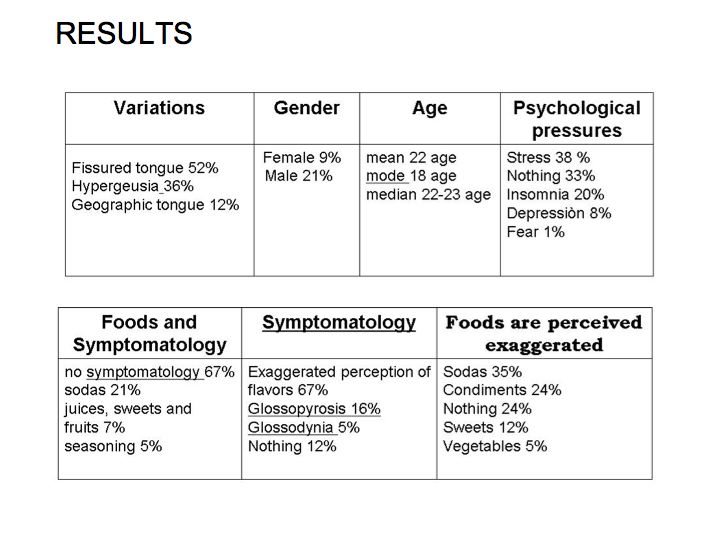ABSTRACT: 3556
Frecuency of variations in the tongue in a Mexican population
| L. DOMÍNGUEZ SALDAÑA1, B.C. ALDAPE1, and B. CRUZ LEGORRETA2, 1Universidad Nacional Autonoma de Mexico, Mexico, D.F, Mexico, 2Universidad Nacional Autonoma de Mexico, Mexico | |
Click on images to view full size. OBJECTIVES: Determine the prevalence of geographic tongue, fissured tongue and hypergeusia in the students of the Faculty of Dentistry; know these lesion's age and gender predilection and symptomatology; establish the kind of food, psychological factors and habits that can trigger them, as well as to distinguish those flavors that are perceived in exaggerated or unpleasant ways in hipergeusia. METHODS: A questionnaire was applied, mainly guided on the prevalence of geographic tongue, fissured tongue and hypergeusia in a population of 332 students of the Faculty of Dentistry at the University of Mexico (UNAM), obtaining a study sample of 43 students that presented one of the three variations; they answered 12 questions focused on the aetiology and symptomatology of the same lesions. CONCLUSIONS: It is concluded that students in an age ranging between 17 and 22 years are, as well as the female gender, the most affected by the presence of any of the three lesions. Fissured tongue has a greater prevalence when compared to hypergeusia and geographic tongue. Aetiology of the variations is multifactorial. Variations are often presented asymptomatically, although glossodynia and glossopyrosis are the most frequent symptoms. An exaggerated perception of flavors is the most common symptom in hypergeusia, being soda, condiments and alcohol the most frequently referred. RESULTS: | |
| Seq #318 - Oral Cancer, Translational Research, and Therapeutics 1:45 PM-3:00 PM, Saturday, July 5, 2008 Metro Toronto Convention Centre Exhibit Hall D-E | |
©Copyright 2008 American Association for Dental Research. All Rights Reserved.
